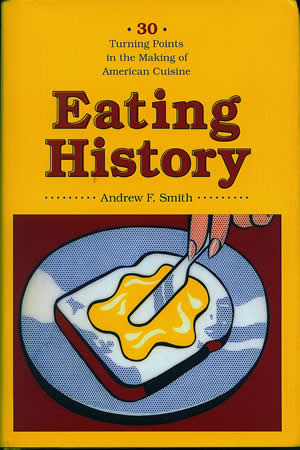Book Review: Eating History
November 3, 2009 —
The turkey’s sitting in the freezer, waiting for you to thaw it out.
You’re using Grandma’s recipe for the dressing, and she’s bringing a pair of her famous pies. Your uncle is furnishing his homemade wine and you know your sister will make that corn thing everybody likes. The Thanksgiving meal is shaping up to be a genuine family event, right down to the table.
But did you ever wonder how the foods in your pantry or freezer got there? Read the new book “Eating History” by Andrew F. Smith(c.2009, Columbia University Press $29.95 / $30.95 Canada – 376 pages, includes notes) and you’ll see what a school principal, a “hack writer”, a savvy ad man, a housewife from Queens, and others had to do with what and how we eat.
Everybody knows that the Pilgrims held the first Thanksgiving after arriving on Plymouth Island. The Indians were there, and they had turkey, roasts, grapes, stew, and root beer they made themselves, right?
Wrong, says Smith. Our traditional beliefs about the first Thanksgiving are largely mythological, created by writers and storytellers. Explorers and natives, for instance, definitely gave thanks for blessings long before the Pilgrims even thought about coming to the new continent, and it was common for several thanksgiving celebrations to be held throughout the year. Furthermore, on the short list above, turkey was the only thing likely to have been at the Pilgrim’s feast.
But let’s say your family tradition is to eat at a restaurant on Turkey Day. You can thank a couple of Italian immigrants for that, Smith says. Before the Delmonico brothers came to America and opened the restaurant that became a 19th-century hotspot, dining out wasn’t socially acceptable at all. “Good” people ate meals at home.
Oh, and by the way… snacking was totally forbidden then, too.
Now, however, you can eat wherever and whatever you want: Chinese, Mexican, fast-food burgers, fried everything, even oatmeal for dinner if that’s what you’re hungry for. Smith says that even those foods changed our cuisine, just as our palates changed other menus. Chop suey is not a “traditional” Chinese dish, for example. Nachos were created in Dallas in the early 1960s. McDonald’s was strictly a drive-up eatery prior to 1968. Dozens of foodstuffs were introduced at world and county fairs. And your love of oatmeal began with a unique and sensational national stunt.
Reading “Eating History” is a little like having a slice of pie in a flavor you’ve never had before. The crust-cover is pretty generic but that never matters. What’s inside looks appetizing, though, and when you bite into it, you’re rewarded with several layers of flavor and tastiness.
By taking a look at how small actions throughout history have influenced our dining habits and celebratory feasts, author Andrew F. Smith appeals to foodies, cooks, and historians with this book. I particularly loved how Smith meanders through his stories, wrapping each up with modern facts and updates.
If you’re looking for a deliciously different book to read between courses this Thanksgiving, here’s one you’ll like. “Eating History” is a toothsome delight.
![]() Submit a comment on "Book Review: Eating History"
Submit a comment on "Book Review: Eating History"
Rich: The Rise and Fall of American Wealth Culture
October 13, 2009 —
A million bucks.
That’s all you’d need to be happy. A measly million… no, wait, TWO million dollars. Imagine all the great things you’d be able to do with those kind of bucks.
But the problem is, believe it or not, that million or two doesn’t go very far anymore, as you’ll see in “Rich: The Rise and Fall of American Wealth Culture” by Larry Samuel (c.2009, Amacom – $24.95 / $32.50 Canada – 308 pages, includes notes). Sometimes, big money isn’t big enough.
Barely 150 years ago, being a millionaire was rare: not only were there just three of them in the U.S. in 1861, but the word itself was brand-new.
Within three generations, wealthy Americans were firmly ensconced in industry, philanthropy, and society. The Have-Nots (meaning, most of the country) were quite fascinated by the European servants, hundred-room mansions, furs and jewelry of the Vanderbilts, Rockefellers, Astors, and their peers.
But then the stock market collapsed, which brought vilification upon the rich. Influential religious leaders spoke against flamboyant displays of wealth, which caused more than a few rich citizens to downsize their homes (or the number of homes). In Washington, a “wealth confiscation bill”, designed to seize and re-distribute big money, actually passed in the Senate (but, obviously, didn’t go into effect).
Post-Depression, a curious shift took place: millionaires were suddenly showing up, not in New York, Boston, and Washington, but in Appalachia and Texas, due to a nation-wide change in energy needs. Following World War II, luxury became something Everyman could have, and the distinction between “Old Money” (wealth from a long line of rich forebears) and “New Money” (fortunes made more recently) became a sticking point within the wealthy class. It was obvious, through attitudes about money, to figure out who was Old and who was New.
In 1966, more than five hundred Americans were millionaires. By 1968, over 100,000 people belonged in that income level. That number doubled by 1970, and for the first time, women, gays, and African Americans were in that category. The introduction of wide-spread lotteries in 1974 made easy millionaires. By the time Forbes magazine introduced “The Forbes Four Hundred” in 1982, there were a dozen billionaires on the list.
Do you scratch your head at the excess of the wealthy? Look askance at those who have “too much much”? Believe it or not, “Rich: The Rise and Fall of American Wealth Culture” puts a lot into perspective.
Author Larry Samuel shows how the average citizen’s perception has changed the way the Rich and Famous behave (and vice versa), and how both have actually altered society and policy. Along the way, Samuel muses about over-the-top ostentation, wealth in politics, and the finer things money can (or can’t) buy. He also gives his readers a subtle clue: most millionaires made their money through stocks and real estate, not by scrimping and saving.
If the Lives of the Definitely Haves have always fascinated you, pick up “Rich: The Rise and Fall of American Wealth Culture”. For historians, cash collectors, upper-crusters, and wanna-be’s, this book is right on the money.
![]() Submit a comment on "Rich: The Rise and Fall of American Wealth Culture"
Submit a comment on "Rich: The Rise and Fall of American Wealth Culture"
Book Review: Flawed Dogs: The Shocking Raid on Westminster
September 20, 2009 —
It isn’t right. It’s just not right, that’s all.
Don’t you hate when you see something wrong and you think you can’t do anything about it because you’re “just a kid”? You spot a mistake in a textbook or a polluted pond or a social injustice, maybe something that could make a difference or change the world, and when you report it, that’s the end of it.
Yeah. You hate that, don’t you?
Sam the Lion was a victim, no doubt, and he waited years for revenge. But in the new book “Flawed Dogs: The Shocking Raid on Westminster” by Berkeley Breathed, (c.2009, Philomel – $16.99 / $21.00 Canada – 240 pages) making things right never went so wrong.
Faced with a dirty plywood enclosure, the smell of money, and a set of sharp teeth, Sam the Lion rolled over on the sawdust and prepared to die. But as he did, his mind wandered back to a time long ago…
Once upon a time, Sam was a very rare, very expensive show dog, a Duuglitz dachshund with the tell-tale tuft atop his head. But because his heart wasn’t ready for the ring and thanks to a last-minute escape at the airport, he ended up living with Heidy McCloud, a young heiress who was suddenly likewise displaced.
Although life at McCloud Heavenly Acres was a little drab, Heidy and Sam brought freshness to the old place. Heidy’s elderly Uncle Hamish loved dogs – he raised rare breeds once - and he welcomed little Sam into the mansion. Heidy and Sam the Lion (her nickname for him) were very happy there.
But it wouldn’t last.
Cassius was the housekeeper’s champion poodle, and he hated Sam. There would be no way he would put up with competition. Cassius devised a plan...
Kicked out of Heavenly Acres and injured, Sam began three years of peoplelessness, pain, and fear. At the bottom of his life, he woke up at The National Last-Ditch Dog Depository.
It was where dogs went when nobody wanted them.
But Sam wanted to make things right. With the help of a pack of new friends, he devised a plan to break into the Westminster Championship Dog Show and get revenge. Cassius would be there.
And so would Sam the Lion.
Much as I love author Berkeley Breathed’s writing, I always struggle with the question of who’s his audience?
My answer with “Flawed Dogs” is, any pet lover from age 11 and up.
Although you’ll probably find this book in the kid’s section – and with classic Breathed illustrations and a meant-for-kids story, that makes sense – this is one that no adult should miss. It’s basically a story of love and miracles, and while kid-readers might not catch that, grown-ups will and they’ll cherish this sweet and silly bring-a-tear novel.
Be aware, when you look for this book, that this is the novel (as opposed to a picture book from a few years back with the same title). If you’re looking for something to read aloud or for a gift this year, “Flawed Dogs” is exactly the right book to find.
![]() Submit a comment on "Book Review: Flawed Dogs: The Shocking Raid on Westminster"
Submit a comment on "Book Review: Flawed Dogs: The Shocking Raid on Westminster"
Book Review: Alibi
August 31, 2009 —
What would you do if an old friend asked you to lie?
Just a little white lie – who would know? One tiny fib is nothing, and it won’t hurt anybody. A little voice in your head says “Go ahead. Do it. ”
But something stops you. You know it isn’t the last you’ll hear of this story. This time, you’ve got your friend’s back… but it might mean a knife in yours later.
And that’s what happened to Daisy Fothergill. One lie is all it took, and in the new book “Alibi” by Teri Woods, the cover-up made Daisy go undercover.
The break-in was supposed to be quick and simple; the pay-off, thousands of dollars and several pounds of cocaine. It should’ve been an in-and-out job but when the smoke cleared, three men lay dead on the floor and Nard was holding the last gun. He saw big trouble coming.
Sticks was supposed to have been there, watching the window, but he wasn’t so he felt duty-bound to help Nard out. Nard was a good soldier, and it wouldn’t make the boss happy if one of his best runners sat in prison. Sticks knew a girl who would lie for him, and Nard needed an alibi.
When Sticks offered Daisy two grand to meet with an investigator, she couldn’t believe her luck. Two thousand dollars to say Nard was with her that night? That was more money than she made dancing at the Honey Dipper.
Unfortunately, it was almost the exact amount needed to bury her mother. It was back to the Honey Dipper for Daisy.
Detective Tommy Delgado felt sorry for the stripper when he and his partner, Merva Ross, questioned her. Even though he never frequented places like the Honey Dipper, this Daisy looked familiar. Ross thought he was getting soft, but Delgado knew this girl was lying and he knew she needed compassion, not jail time.
But one small lie needs an even bigger one to back it up and Daisy took notice of the people who were dying to hide the truth. So when $47,000 showed up in her dead mother’s bank account, she took it to cover her backside, and ran for her life.
I sat down with this book at 8 o’clock on a Monday night.
I was still reading at midnight. Bedtime could wait; I had to know what happened in this fast-paced, can’t-stop-reading book.
“Alibi” is one of those street-smart novels that really gets in your face. Focusing more on the criminals than on the cops charged with catching them, author Teri Woods builds the story at just the right pace, never letting us know how things are going to end for the one character we’ve oddly come to care about. Add in a couple of well-turned plot lines, and you’ve got a book that will keep you up all night, too.
Pick up a copy of “Alibi” and hang on to your blankets. This is one novel you’ll want to read in one sitting, cover to cover.
![]() Submit a comment on "Book Review: Alibi"
Submit a comment on "Book Review: Alibi"
















